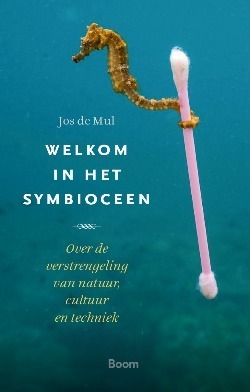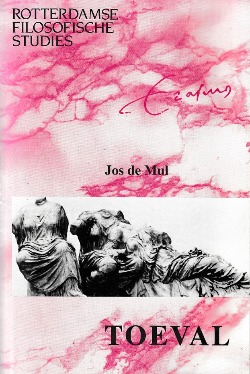Jos de Mul. Database aesthetics. Weblog Jos de Mul.
The psychoanalyst Abraham Maslov once remarked that for someone who only has a hammer, everything appears to be a nail. For a globaliz ing culture, in which the computer rapidly has become the main instrument, the world becomes a gigantic database.
We see this database ontology at work when, for example, information technology is deployed in the field of genetic manipulation. The gene pool of life on earth is then no longer primarily conceived as a contingent and factual evolutionary constellation, but rather as a database of an infinite number of virtual life forms that can be actualized at will. In other words, the artistic collage has become a reality-creating tech nology. Biologists use computer programs that can simulate alternative evolutions in order to create specific alternatives to reality. Not only can past life forms be revitalized by in formation-technological manipulation but by contingent or intended mutations; even future possibilities become objects of manipulation (a specific form of what Anthony Giddens calls ‘the colonization of the future’). Although not yet as in as spectacular a way as in Spielberg’s Jurassic Park or in sci ence fiction films such as Robocop, our world is increasingly populated with new, transgenetic life forms (and thus with new forms of post-natural beauty and ugliness), created with the aid of informational bio-technologies.
What applies to physical and biological reality also applies to social and cultural reality, rich domains for the database ontology. We no longer follow, as pre-modern people did, certain habits, customs and norms because there are no other alternatives (known); nor do we, as modern people did, deliberately choose certain options out of a deep conviction. Instead, these cultural genes (called “memes” by Richards Dawkins), are more or less randomly taken from the “meme pool” of the various increasingly globalizing cultures on earth.
The recombination character of post-historic culture is not altogether new. AlI cultures, pre-modern and modern culture no less than postmodern cultures, are composed of heteroge neous elements, partly derived from other cultures. Modern art, for example in techniques such as collage which we find in the works of Picasso, can be regarded as an artistic foreshadowing of post-modern and posthistoric inter-culture. The difference, however, is that where Picasso was still completely dependent on the historical worldview his collages are clearly assembled from elements of the historical world post-his toric art works are characterized by a hybrid fusion of past, present and future, temporal ambiguity and virtuality. The post-modern movement in the eighties and nineties reflected this development. A nice example of such Database-Art was recently shown in the Kiasma Museum for Contemporary Art in Helsinki in the exhibition Love me or leave me. It was a work made by the Finnish artist Jan-Erik Andersson, entitled The Triangle, the Square and the Circle. Meet the Fast-Food-Boat (1988). The Fast-Food-Boat in this installation offers an interesting menu, consisting of plates recombining a whole series of icons of twentieth-century art. Those who are hungry for Fusion Art can choose, for example, Malewich Flakes with Kiefer Sauce, A Keith Haring Herring or A Sol le Witt Cube with Pollock Dressing. However, the once primarily artistic cut-and-paste technique has become the engine of the production of inter cultural forms in many domains
The post-historic world I am sketching here should not be con fused with the post-historic as it is used by philosophers and historians such as Belting, Danto, and Fukuyama. Following Hegel’s secular version of the Christian eschatology, they use the term “post-historic” to refer to the end of a specific linear development in history. In the case of Hegel and Fukuyama, it refers to a specific political development which results in the completion of an idea (respectively the absolute Prussian state and politico-economical liberalism), after which a period of post-history starts in which important political events no longer occur. However, as the real existing history of interna tional terrorism and the economical and cultural rise of China has shown us during the last decade, the idea of a post-historic world order in this specific sense is rather naive.
In the case of Belting and Danto, the same argument is de fended with regard to the history of art: After the completion of art in conceptual art, everything has become possible, but no longer will any real further development take place. When we look, at the one hand, at the emergence of digital imaging, hyper novels, interactive movies, Net-art, computer games (perhaps following film in its development from sheer amuse ment into a new artform) and the like, and, at the other hand, to the growing global impact of non-western art and aesthetics, we have to admit that it is equally naïve (and Western-centric) to speak about the end of art.
What distinguishes the post-history to which I refer from the neo-Hegelian post-history is its break from the very notion of linear development. If we can speak of an end of history at all, the phrase will refer to the necessity of putting an end to the use of the concept of “the end.” This does not mean, however, that no temporal experience exists in post-historic consciousness. Should we wish to put forward an early repre sentation of this post-historic temporal experience, we could think about the chance music of the American composer John Cage. When in response to one of Cage’s composi tions, a listener who had grown up in the classical, linear music tradition asked the composer if this aleatoric music actually had a beginning, a middle and an end, Cage an swered that of course it did, but not necessarily in that order. Informational post-history differs from the Cage’s early ex pression of it by the way it refers to the non-linear development that occurs in many dimensions at the same time. It is like playing all of Cage’s aleatoric compositions simultaneously or playing all possible courses a game virtually can take at the same time. Or to refer once more to the intercultural dimen sion of our present world, it is like simultaneously living in many cultures at the same time.
For those who will populate this post-historic world, and I think this already applies to young people growing up in a world of digital multimedia, the historical consciousness that for a number of centuries has determined human experience will probably become as strange as the static worldview of pre-modern times had become for modern humans who had historical consciousness. For post-historic consciousness, linear progress as such will probably be an unimaginable category.
Let me conclude with three tentative thoughts about the implications of the database ontology just sketched for the arts and aesthetics. The first regards the relationship between mobility and innovation. Cultures always have been mobile. However, as the processes of artistic mobility and innovation in pre-modern societies still took place rather slowly, pre modern aesthetics often holds that aesthetic categories such as beauty have a timeless and even eternal character. However in modern culture, characterized by increasing mobility and constant artistic innovation, aesthetics also became historical, as we see reflected in the history of Western aesthetics since Hegel.
In modern aesthetics, mobility and innovation even became the key concepts in the understanding of art. In the post-mod ern aesthetics that dominates today, this is no longer the case. However, it does not mean that the concept of mobility too has lost its meaning. The post-historic aesthetics that is emerging today perhaps can best be understood by Nietzsche’s concept of the Eternal Recurrence of the Same. This concept refers to a universe that is built up of a finite number of elements that are constantly being recombined over an infinite course of time, inevitably leading to the recurrence of every possible recom bination. Perhaps this concept can help us re-think mobility beyond the immobility that is inherent in the aforementioned aesthetics of Hegel and post-Hegelians such as Danto. It will help us realize that it is not so much art that comes to an end but rather the discourse about that modern event.
My second remark regards the value of the elements of the aesthetic database. Walter Benjamin has made a famous distinction between cult value and exhibition value. The pre-modern artwork was considered to be unique in time and space. This made sense, since there was, and still is, only one Mona Lisa, and if you want to see it you have to go to the Louvre in Paris. It was because of its very uniqueness that the pre-modern work of art could become a cult object of admiration and even of worship. According to Benjamin, in the age of technological reproduction in which artworks such as prints, photos and movies can be reproduced infinitely, it is no longer the uniqueness of the object that determines its aesthetic value but rather its exhibition value: the way in which it appears as a reproduction. In this context Benjamin prophetically referred not only to aesthetics but to politics as well. Nowadays the value of a politician is predominantly determined by his or her exhibition value: the way he or she appears in the media.
In the age of the database ontology, yet another value comes to the fore. Aesthetic value will increasingly be dependent on an object’s manipulability. Only those entities that are open to computer-mediated manipulation and recombination count as valuable. It is easy to see, for example, why the manipulation value of a digitalized library is much greater than that of a traditional collection of printed books. I expect that the aesthetic value of post-modern works of art will also increasingly depend on their manipulation value. Speaking of media as such, I guess that most people are of the opinion that the aesthetic value of the film is greater than that of the magic lantern because the former adds the dimension of motion to the aesthetic experience. We are entering an age in which the aesthetic value of digitally manipulative entities surpasses that of entities whose constitutive elements are chained in spatial or temporal necessity.
The database ontology not only affects the arts but reflection on the arts as well. Mobile arts require mobile aesthetics. Such an aesthetics will be mobile not only because it focuses on the hypermobility of its object but also because it will be mobile itself. We see a first glimmer of such an aesthetics when reflection moves to hypermedia environments. In these interactive and often intercultural environments, reflection no longer results in a linear chain of arguments but rather in a logical space that enables the user, who will be both a writer and a reader, to (re)construct his or her own arguments and those of others.
The global development of database ontology involves many threats, but creates wonderful challenges as well, both for the arts and for aesthetics.









